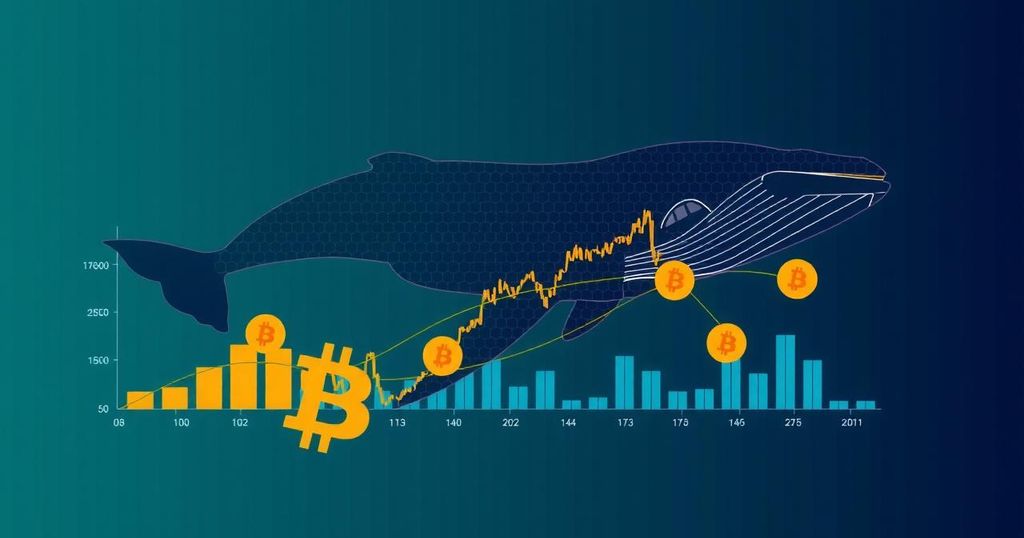Bitcoin Faces Potential Decline with Whale Selling and ETF Outflows
The cryptocurrency market is currently experiencing significant volatility, particularly in regard to Bitcoin, which appears to be on the brink of a notable decline. As large-scale investors, commonly referred to as “whales,” continue to liquidate their Bitcoin holdings, concerns surrounding potential market capitulation have risen sharply. On Thursday, Bitcoin concluded trading below a crucial support threshold of $57,000. By Friday, September 6, the cryptocurrency had witnessed a further decline exceeding 3%, settling around $55,360 during the mid-London trading session. This downturn has adversely affected the altcoin market as well, with major cryptocurrencies such as Ethereum (ETH) and Solana (SOL) reflecting Bitcoin’s negative trajectory.
The short-term prognosis for Bitcoin remains dire, with numerous analysts indicating the possibility of further declines. The existing correlation between Bitcoin and altcoins remains robust, as investors increasingly gravitate towards emerging web3 technologies in search of higher returns. Arthur Hayes, the co-founder of Bit MEX, has warned that Bitcoin’s price may potentially plunge below $50,000 over the weekend, a prediction that significantly contributes to the prevailing anxiety in the market. Additionally, seasoned trader Peter Brandt has forecasted a decline toward $46,000, citing the formation of a macro megaphone pattern on the charts.
Brandt’s analysis emphasizes that the intense selling pressure is overshadowing any buying momentum, leading to a bearish outlook. According to him, the threat of further declines remains pronounced unless Bitcoin can consistently maintain closing prices above $65,000 while rallying toward $70,000.
Further exacerbating the pessimistic sentiment, on-chain data reveals a rapid increase in sell-offs by whale investors, which has been a central factor in Bitcoin’s depreciating price. The Bitcoin Fear and Greed Index, which gauges market sentiment, has plummeted to 22%, indicating “Extreme Fear.” This stark drop suggests that investors are apprehensive about a potential market collapse.
Recent data from Look on Chain has recorded that a whale investor deposited 4,544 BTC, valued at approximately $265 million, into Binance within the past week. In a single day, this same whale contributed an additional 380 BTC, equating to over $21 million, which has only intensified market fears. Such substantial sell-offs typically portend difficulties for retail traders, often triggering a chain reaction of further declines in prices.
Compounding these troubles, U.S. spot Bitcoin Exchange-Traded Funds (ETFs) are also facing significant capital outflows. Over the last week, spot Bitcoin ETFs have suffered seven consecutive days of net cash withdrawals, with Thursday alone seeing an outflow of approximately $211 million. Fidelity’s FBTC ETF has borne the brunt of these losses, contributing $149 million to the total withdrawal amount.
The ongoing outflows from U.S. spot Bitcoin ETFs have further fostered a bearish market sentiment. These ETFs serve as a primary mechanism for institutional investors seeking exposure to Bitcoin, and the net outflows indicate that even these larger players are expressing caution regarding the cryptocurrency’s short-term prospects. Such a mass withdrawal from Bitcoin ETFs signifies that additional price declines may be imminent.
Despite the prevailing negative market atmosphere, some analysts are optimistic about a potential broader bull market developing in the fourth quarter of 2024, with possible spillovers into early 2025. The imminent Federal Reserve interest rate decision on September 18 is viewed as pivotal for the crypto market. Should the Fed opt to lower interest rates, as many market participants anticipate, it could provide a significant uplift to risky assets, including Bitcoin, thus potentially laying the groundwork for a renewed rally.
Nevertheless, in the immediate term, the market is characterized by high volatility, with the supply of Bitcoin available on centralized exchanges gradually decreasing over the past five months. This trend indicates that long-term investors, including major entities like BlackRock, are retaining their Bitcoin holdings despite recent price fluctuations. Such long-term holders are less inclined to react to short-term volatility, which could offer market stability once the selling pressure from whales diminishes.
In conclusion, Bitcoin’s short-term outlook remains precarious as predictions of a potential dip below $50,000 loom large. Whale sell-offs, coupled with ongoing outflows from U.S. spot Bitcoin ETFs, contribute to a hazardous sentiment environment, as evidenced by the sharp decline in the Fear and Greed Index. While there exists hope for a forthcoming robust market, the current landscape is fraught with uncertainties. Investors are advised to exercise caution and remain vigilant in monitoring essential developments, such as the Federal Reserve’s impending interest rate decision. Until Bitcoin breaks free from its existing bearish trend and gains momentum above $65,000, the risk of further losses will likely persist.
Get the latest updates on cryptocurrency and blockchain news delivered directly to your inbox.








Post Comment